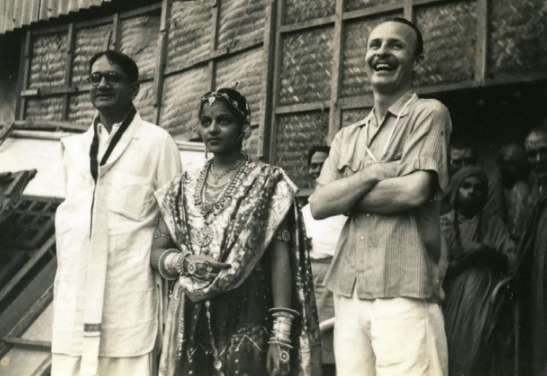
Kindred souls
The two largest democracies in the world, India and USA, are often spoken of in one breath in various contexts. It also tends to place the affinity between these two nations to modern times, i.e. India in post- Independence era. However, the interaction between the countries across the seas happened from a much earlier time as an exhibition titled Kindred Nations: The United States and India 1783-1947 held at the Indian Museum, Kolkata, demonstrated. Curated by the Meridian International Center, Washington D.C., the exhibit covering a multitude of themes depicted through photographs, paintings and documents, threw up nuggets of information on how even when Britain dominated the sub-continent, the two developed a bond that only strengthened in time.
Ironically, it was the British colonialists who facilitated one of the most interesting connections between Kolkata (then Calcutta) and America- through trade. When America won the War of Independence shaking off its colonial status under Britain, it also meant that the restrictions on American private merchants which had prevented them from sending ships to India were withdrawn.
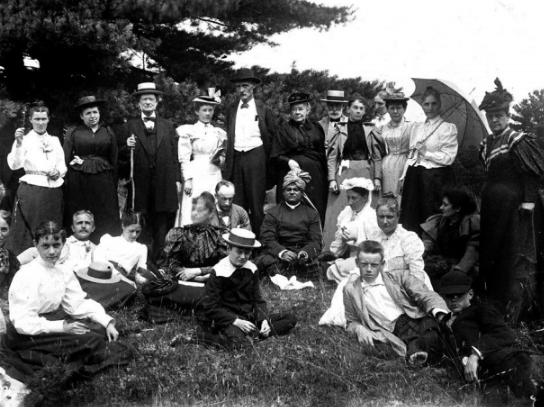 Trade between the countries flourished. Calcutta, then the hub of British trade in India courtesy the East India Company, had great many Europeans who yearned for iced drinks in the humid climate. So when Boston’s “Ice King,” Frederic Tudor sent the first cargo shipment aboard the Tuscany, arriving in September 1833, it was a huge event that figured in the local newspapers prominently. Reports elaborated how people lined up at Calcutta port on the bank of the Hooghly to witness unloading of this unusual cargo. Even for Lindsay Amini, director of cultural programmes at the Meridian International Center (MIC), it was “One of the most surprising stories” as she and her team leafed through hundreds of material to curate the exhibition. “The idea of 100 tons of ice being shipped by boat over a four-month period without the refrigeration techniques available today was absolutely fascinating. Nearly half the shipment had melted along the way.”
Trade between the countries flourished. Calcutta, then the hub of British trade in India courtesy the East India Company, had great many Europeans who yearned for iced drinks in the humid climate. So when Boston’s “Ice King,” Frederic Tudor sent the first cargo shipment aboard the Tuscany, arriving in September 1833, it was a huge event that figured in the local newspapers prominently. Reports elaborated how people lined up at Calcutta port on the bank of the Hooghly to witness unloading of this unusual cargo. Even for Lindsay Amini, director of cultural programmes at the Meridian International Center (MIC), it was “One of the most surprising stories” as she and her team leafed through hundreds of material to curate the exhibition. “The idea of 100 tons of ice being shipped by boat over a four-month period without the refrigeration techniques available today was absolutely fascinating. Nearly half the shipment had melted along the way.”
One of the offshoots of this opening up had influenced even the educational and cultural fields in India as the East India Company lifted its ban on American missionaries in 1813. A less known fact is that American Baptist missionaries introduced modern education and literature in the Brahmaputra valley in the North East. Evangelist Nathan Brown who learnt the ‘sweet’ Assamese language and Miles Bronson, a linguist, opened Assamese language schools, wrote the first grammar in Assamese, compiled a dictionary, and published the first Assamese magazine called Orunodoi (1846) loaded with information. The missionaries’ contribution to ‘the collective life of the Assamese people’ has been well recognised by scholars. The North East connection was, however, not part of this exhibition.
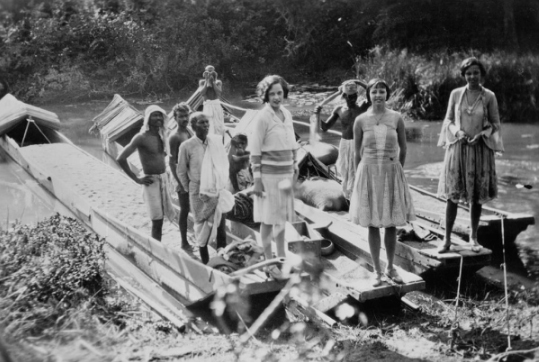 Swami Vivekananda’s famous speech at the World Parliament of Religions in Chicago (1893) where he charmed the audience by addressing them as ‘sisters and brothers of America’ is recalled by a photograph of him surrounded with admirers at Green Acre School, Maine
Swami Vivekananda’s famous speech at the World Parliament of Religions in Chicago (1893) where he charmed the audience by addressing them as ‘sisters and brothers of America’ is recalled by a photograph of him surrounded with admirers at Green Acre School, Maine
The exhibit packed in some rare insights into Indo-American connection through rare photographs. Like that of a baby elephant. In 1796, the first live elephant landed in America transported by the ship America. The elephant drew huge crowds in cities in the East Coast who paid twenty-five cents a head to view this exotic animal. Or, a portrait of Anandibai Joshee , the first Indian woman to earn a medical degree in America (1886); on return she worked as physician-in-charge at the Albert Edward Hospital’s female ward in Kolhapur.
Another showed Sikh immigrants arriving by the ship SS Minnesota, turban and all. Then there was the Hollywood connection. India-born actress Merle Oberon is seen on a set (in the class-conscious colonial era she had long suppressed the fact that her mother was an Anglo-Indian); another Hollywood star Sabu Dastagir, the Mowgli of The Jungle Bookfame (precursor of the current animation hit film by Disney), who later became an American citizen and fought as an Air Force officer and earned the Distinguished Flying Cross. In India, on the other hand, director R. Dungan, already a success in the Madras (Chennai) film industry, is seen with cast member on the set of Meera (1945) which had legendary singer M. S. Subbulakshmi in the title role.
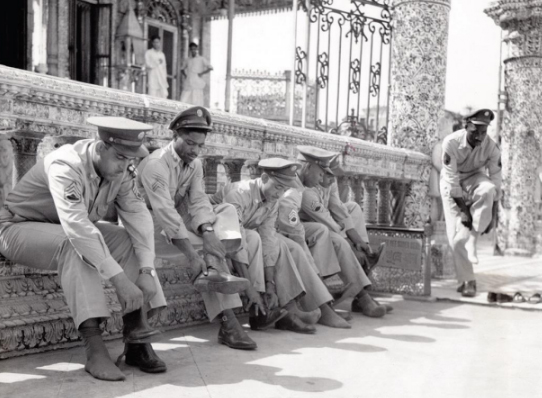 The Second World War, like countries worldwide, also singed India. There is an evocative photo of US soldiers taking off their shoes to enter the famous Jain temple in Kolkata; another shows world champion boxer Henry Armstrong as a soldier giving impromptu lessons to local boys.
The Second World War, like countries worldwide, also singed India. There is an evocative photo of US soldiers taking off their shoes to enter the famous Jain temple in Kolkata; another shows world champion boxer Henry Armstrong as a soldier giving impromptu lessons to local boys.
The 1940s were turbulent years for India’s freedom struggle. One picture shows Mahatma Gandhi with President Herbert Hoover (1946) when he was on a worldwide food survey of food conditions. Another shows American sympathisers getting arrested while demonstrating in Washington D.C. with the message ‘It’s 1776 for India’ drawing a simile with America’s Independence movement.
Said Amini, who was in Kolkata during the event, “Knowing the affinity between the two countries we wanted to create an exhibition that shares not only the key historical moments, but some of the little known interactions between Americans and Indians before India’s independence.”
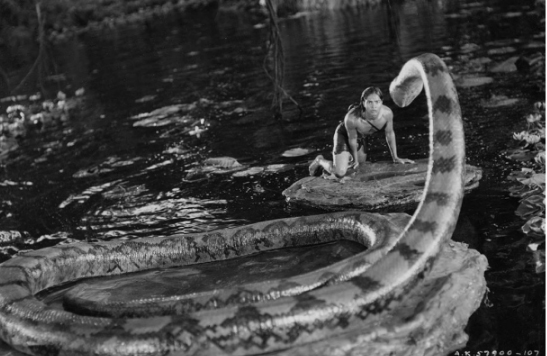 When asked if it difficult to curate the exhibition, she said, “The process was definitely labour intensive. Our team worked for a year with archivists around the US at museums, universities, presidential libraries, historical societies, and also private collections,”
When asked if it difficult to curate the exhibition, she said, “The process was definitely labour intensive. Our team worked for a year with archivists around the US at museums, universities, presidential libraries, historical societies, and also private collections,”
Even then the team was amazed at the immense amount of images and stories discovered. Sifting through these thousands of images, they worked with Susan Bean, an Indo-U.S. expert, to curate the exhibition down to around 60 images that captures the larger story.
Amini agrees that given all the content that Meridian found during the research, “It is definitely a rich topic that could be explored further Kindred Nations is just a sampling of the kinds of stories that are out there.”
(Photo courtesy MIC)
Support Our Journalism
We cannot do without you.. your contribution supports unbiased journalism
IBNS is not driven by any ism- not wokeism, not racism, not skewed secularism, not hyper right-wing or left liberal ideals, nor by any hardline religious beliefs or hyper nationalism. We want to serve you good old objective news, as they are. We do not judge or preach. We let people decide for themselves. We only try to present factual and well-sourced news.







